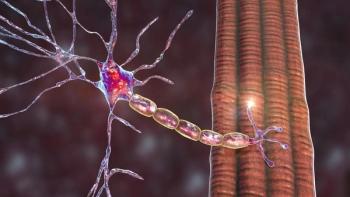
Multiple Sclerosis Cell Therapy Demonstrates Promising Safety and Efficacy in Phase 2 Trial
Nearly 20% of treated patients achieved at least 25% improvement in timed 25-foot walk speed and/or 9-Hole Peg test at 28 weeks.
BrainStorm Cell Therapeutics’ NurOwn, an investigational autologous mesenchymal stem cell (MSC) neurotrophic factor–secreting cell therapy product, demonstrated encouraging preliminary safety and efficacy data in an open-label phase 2 clinical trial (NCT03799718) in patients with primary or secondary progressive
Among the 18 participants who were treated, 19% achieved at least 25% improvement compared with baseline in timed 25-foot walk speed (T25FW) and/or 9-Hole Peg test (9-HPT) at 28 weeks post-treatment. Additionally, increases in neuroprotective factors in the cerebrospinal fluid (CSF) were observed after treatment, and decreases in inflammatory biomarkers were observed. In terms of safety, no deaths or adverse events (AEs) related to worsening of MS, clinical or MRI evidence of disease activation, or clinically significant changes in safety lab results were observed. Two patients each experienced lower back pain and leg pain symptoms consistent with arachnoiditis following 1 of the 3 intrathecal administrations of NurOwn.
"This publication provides preliminary evidence of NurOwn's potential to modify functional outcomes in progressive MS, which we believe warrants further study,” Ralph Kern, MD, MHSc, president and chief medical officer, BrainStorm Cell Therapeutics, and co-author of the paper, said in a statement.2 “In addition, consistent changes in cerebrospinal fluid neuroinflammation and neuroprotection biomarkers reveal how NurOwn may impact disease mechanisms in progressive MS and are complementary to biomarker results observed in our phase 3 ALS trial. These observations provide further support for NurOwn as a platform technology with potential broad applications and will bolster BrainStorm's efforts to bring much needed solutions to patients with progressive MS, ALS, and other neurodegenerative diseases."
The study screened 23 patients in total, and 20 underwent bone marrow aspiration.1 Autologous bone marrow culture did not yield a sufficient number of
Among the 18 treated participants, 38% demonstrated at least 10 points improvement from baseline on the 12-item multiple sclerosis walking scale (MSWS); 27% showed at least an 8-letter improvement in low contrast letter acuity (LCLA) binocular at a 2.5% contrast threshold; 67% demonstrated at least 3 points of improvement in the symbol digit modality test (SDMT); and 47% demonstrated at least 8 points of improvement in LCLA binocular at a 1.25% contrast threshold. By contrast, among matched CLIMB registry patients, 4% achieved 25% or better improvement on T25FW or 9HPT at 28 weeks; 6% showed an 8-letter or more improvement in LCLA binocular at the 2.5% contrast threshold; and 18% showed a 3-point or higher improvement on SDMT. CLIMB registry data was unavailable for the 12-item MSWS and LCLA binocular at a 1.25% contrast threshold.
“We did not observe changes in MRI FLAIR lesion count or volume, suggesting the absence of measurable disease activity during the clinical trial. Therefore, it is not possible to extrapolate the observations in this study to PMS patients experiencing clinical or MRI disease activity,” Kern and colleagues wrote, acknowledging a limitation of the study.1 They also pointed out that “this small open-label study did not directly compare treatment outcomes with a randomized placebo-treated group; therefore, the interpretation of efficacy data may be limited by expectation bias. A limitation of the biomarker analysis was that the third CSF specimen was obtained just prior to the third treatment and, therefore, only reflects the effect of the first two treatments.”
The investigators concluded that the findings of the study were encouraging in terms of NurOwn’s safety profile, the efficacy data, and the positive biomarker data. However, they also highlighted the importance of confirming these results with a future placebo-controlled trial. They additionally pointed out that further investigation is necessary to determine the role and usefulness of several of the biomarkers examined in assessing efficacy for PMS treatment.
REFERENCES
1. Cohen JA, Lublin FD, Lock C, et al. Evaluation of neurotrophic factor secreting mesenchymal stem cells in progressive multiple sclerosis. MultScler. Published online September 14, 2022:135245852211221. doi:10.1177/1352458522112215
2. Brainstorm Cell Therapeutics announces peer reviewed publication of results from the Nurown® phase 2 progressive MS trial in multiple sclerosis journal. News release. BrainStorm Cell Therapeutics Inc. September 15, 2022. https://ir.brainstorm-cell.com/2022-09-15-BrainStorm-Cell-Therapeutics-Announces-Peer-Reviewed-Publication-of-Results-from-the-NurOwn-R-Phase-2-Progressive-MS-Trial-in-Multiple-Sclerosis-Journal
Newsletter
Stay at the forefront of cutting-edge science with CGT—your direct line to expert insights, breakthrough data, and real-time coverage of the latest advancements in cell and gene therapy.












































